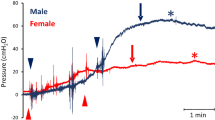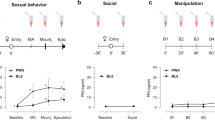Abstract
There have been limited anatomic and physiological investigations of the female sexual arousal response. A broader understanding of the physiologic mechanisms of female sexual arousal function is required to improve the management of women with sexual dysfunction. Three experimental test systems have been developed to understand better the biochemical and physiological mechanisms of female sexual arousal response. An in vivo animal model was developed to record physiological and hemodynamic changes in the clitoris and vagina following pelvic nerve stimulation and administration of vasoactive agents and physiological modulators. In vitro organ baths of clitoral and vaginal tissue were utilized to investigate mechanisms involved in the regulation of smooth muscle contractility. In addition, primary cell cultures of human and animal clitoral and vaginal smooth muscle cells were developed to investigate signal transduction pathways modulating smooth muscle tone. In vivo studies revealed hemodynamic changes in vagina and clitoris in response to pelvic nerve stimulation, vasodilators and physiological modulators. Organ bath studies have demonstrated that clitoral and vaginal smooth muscle tone is affected by non-adrenergic and non-cholinergic neurotransmitters, and the presence of functional alpha 1 and alpha 2 adrenergic receptors in these tissues has been established through biochemical studies. These changes are regulated by the tone of vascular and non-vascular smooth muscle in the vagina and clitoris. Primary cell culture studies have suggested that several physiological modulators such as vasoactive intestinal polypeptide (VIP), nitric oxide (NO), and prostaglandin E (PGE) regulate vaginal smooth muscle contractility. Data from experimental models have provided a preliminary understanding of the mechanisms of the female sexual arousal response.
This is a preview of subscription content, access via your institution
Access options
Subscribe to this journal
Receive 8 print issues and online access
$259.00 per year
only $32.38 per issue
Buy this article
- Purchase on Springer Link
- Instant access to full article PDF
Prices may be subject to local taxes which are calculated during checkout
Similar content being viewed by others
References
Laumann EO, Paik A, Rosen RC. . Sexual dysfunction in the United States: prevalence and predictors. JAMA 1999 281, 537–544.
Masters EH, Johnson VE. . Human Sexual Response Little, Brown & Co: Boston 1966.
Kaplan HS. . The New Sex Therapy Bailliere Tindall: London 1974.
Basson R et al. Report of the international consensus development conference on female sexual dysfunction: definition and classifications. J Urol 2000 183, 888–893.
Laan E, Everaerd W. . Physiological measures of vaginal vasocongestion. Int J Impot Res 1998 10(Suppl 2), S107–S110.
Levin RJ. . Sex and the human female reproductive tract—what really happens during and after coitus. Int J Impot Res 1998 10(Suppl 1), S14–S21.
Meston CM, Heiman JR. . Ephedrine-activated physiological sexual arousal in women. Arch Gen Psychiatry 1998 55, 652–656.
Meston CM, Gorzalka BB, Wright JM. . Inhibition of subjective and physiological sexual arousal in women by clonidine. Psychosom Med 1997 59, 399–407.
Ottesen B et al. Vasoactive intestinal polypeptide (VIP) provokes vaginal lubrication in normal women. Peptides 1987 8, 797–800.
Park K et al. Vasculogenic female sexual dysfunction: the hemodynamic basis for vaginal engorgement insufficiency and clitoral erectile insufficiency. Int J Impot Res 1997 9, 27–37.
Read S, King M, Watson J. . Sexual dysfunction in primary medical care: prevalence, characteristics and detection by the general practitioner. J Public Health Med 1997 19, 387–391.
Rosen RC et al. Prevalence of sexual dysfunction in women: results of a survey study of 329 women in an outpatient gynecological clinic. J Sex Marital Ther 1993 19, 171–188.
Min K et al. Sildenafil augments pelvic nerve-mediated female genital sexual arousal in the anesthetized rabbit. Int J Impot Res 2000 12(Suppl 3), S32–S39.
Hoyle CH et al. Innervation of vasculature and microvasculature of the human vagina by NOS and neuropeptide-containing nerves. J Anat 1996 188, 633–644.
Palle C et al. Vasoactive intestinal polypeptide and human vaginal blood flow: comparison between transvaginal and intravenous administration. J Clin Exp Pharm Physiol 1990 17, 61–68.
Levin RJ. . VIP, vagina, clitoral and periurethral glans—an update on human female genital arousal. Exp Clin Endocrinol 1991 98, 61–69.
Traish A et al. Development of human and rabbit vaginal smooth muscle cell cultures: effects of vasoactive agents on intracellular levels of cyclic nucleotides. Mol Cell Biol Res Commun 1999 2, 131–137.
Laan E, van Lunsen RH. . Hormones and sexuality in post-menopausal women: a psychophysiological study. J Psychosom Obstet Gynaecol 1997 18, 126–133.
Sarrel PM. . Ovarian hormones and vaginal blood flow: using laser Doppler velocimetry to measure effects in a clinical trial in post-menopausal women. Int J Impot Res 1998 10(Suppl 2), S91–S93.
Sarrel PM. . Sexuality and menopause. Obstet Gynecol 1990 75(Suppl), S26–S30.
Stenberg A, Heimer G, Ulmsten U. . The prevalence of urogenital symptoms in post-menopausal women. Maturitas 1995 22(Suppl), S17–S22.
Acknowledgements
This work was supported by grants DK02696 and DK56846 from the NI DDK.
Author information
Authors and Affiliations
Corresponding author
Rights and permissions
About this article
Cite this article
Min, K., O'Connell, L., Munarriz, R. et al. Experimental models for the investigation of female sexual function and dysfunction. Int J Impot Res 13, 151–156 (2001). https://doi.org/10.1038/sj.ijir.3900683
Published:
Issue Date:
DOI: https://doi.org/10.1038/sj.ijir.3900683
Keywords
This article is cited by
-
Expressions of vaginal endothelial nitric oxide synthase and phosphodiesterase 5 in female sexual dysfunction: a pilot study
International Urogynecology Journal (2017)
-
In vitro functional responses of isolated human vaginal tissue to selective phosphodiesterase inhibitors
World Journal of Urology (2005)
-
Topical administration of a novel nitric oxide donor, linear polyethylenimine-nitric oxide/nucleophile adduct (DS1), selectively increases vaginal blood flow in anesthetized rats
International Journal of Impotence Research (2003)
-
Morphological modifications in clitoris and vagina in spontaneously hypertensive rats
International Journal of Impotence Research (2003)



